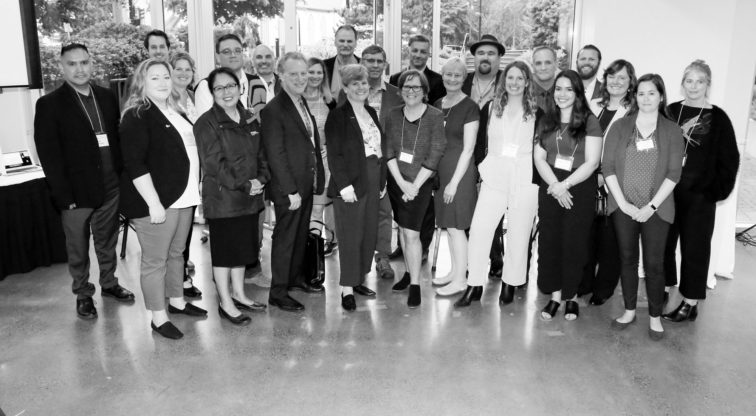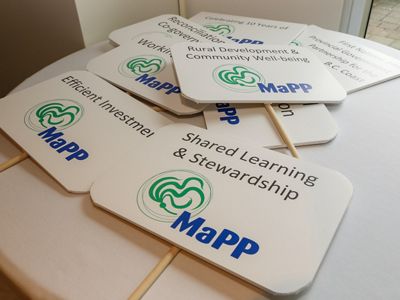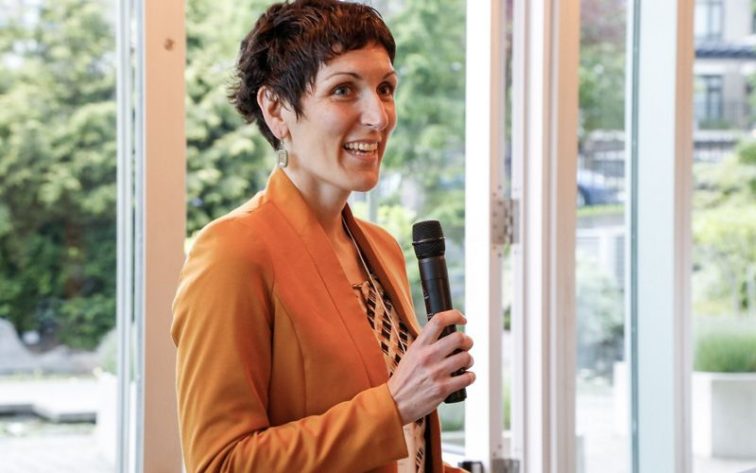On June 1, Nature United hosted a celebration for the 10-year anniversary of the world’s first co-led marine planning effort with Indigenous Peoples.

MaPP 10 year celebration, group shot. June 1, 2022. © Allison Penko
When people come together under a common vision, they can accomplish wonderful things. And the Marine Plan Partnership—or MaPP—is truly a wonderful thing.
The truth is, I’m not sure many people fully appreciate just how significant it is to have 17 different First Nations working collaboratively with a crown government to advance ecosystem-based management. MaPP has been successfully doing this for 10 years.
It’s unprecedented. It’s something we should celebrate. It’s something that should be supported into the future.
Building on the world-renowned agreements for conservation and land use in the Great Bear Rainforest and Haida Gwaii, the Province of British Columbia and 17 First Nations collaboratively developed the world’s first collaborative large-scale marine planning initiative.
A Shining Example
Ten years later, MaPP is still a leading partnership model for governments working together on complex collaborative marine spatial planning. Integrating healthy ecosystems, economies and people, this partnership represents the kind of conservation that’s possible through bold collaboration.
It was wonderful to have the chance to celebrate this milestone in person. On June 1, 2022 Nature United hosted an event where First Nations MaPP partners from up and down the coast came together with B.C. government MaPP partners to celebrate 10 years of working together. The celebratory energy in the room was palpable.
“This partnership is a shining example of how First Nations and the provincial government collaborate to find solutions to difficult problems, all in the interest of maintaining the health of coastal marine ecosystems and fostering sustainable development opportunities,” said Minister of Land, Water and Resource Stewardship Josie Osborne in remarks at the event. “The partnership is strengthened by everyone who contributes to its ongoing development.”

CELEBRATORY ENERGY During a celebration of the 10 year anniversary of the Marine Plan Partnership, a performance by the Numwayut Culture Group welcomed the attendees. © Allison Penko

BOLD COLLABORATION Placards highlighting the key outcomes of the Marine Plan Partnership. © Allison Penko
Modeling Reconciliation
MaPP has been, and continues to be an important model and success story—one that First Nations and the government of B.C. can look to as they move forward on reconciliation and implementing B.C.’s Declaration on the Rights of Indigenous People’s Act.
In 2021, MaPP received an inaugural British Columbia Reconciliation Award, which celebrates exceptional leadership, integrity, respect, and commitment to furthering reconciliation with Indigenous peoples in B.C.
MaPP is in fact the world’s first co-led Marine Spatial Plan between Indigenous Governments and Crown Governments. Since it was signed, it has provided inspiration to other countries developing marine plans with Indigenous peoples in places like New Zealand, Indonesia and Costa Rica.

Jenn Burt of Nature United hosted the MaPP 10-year celebration. © Allison Penko
MaPP is in fact the world’s first co-led Marine Spatial Plan between Indigenous Governments and Crown Governments.
JENN BURT
Marine Program Lead
Lasting Impact
This co-led planning process means the results of MaPP will last for generations to come. With stronger Indigenous governance and more agreement on priority issues, these comprehensive plans have made tangible outcomes possible.
In the last 10 years, MaPP has:
- enhanced ecosystem monitoring, including kelp, estuaries, invasive species and much more;
- compiled a huge foundation of data on the species, habitats, cultural resources, and human activities within the waters of Northern B.C.;
- piloted projects for sustainable economies, like shellfish and seaweed aquaculture and recreational trail development;
- identified 4 million acres of protected management zones, many of which are now prospective sites for federally legislated Marine Protected Areas;
- created efficiencies for coastal tenure authorizations, ensuring sound placement, environmental compatibility, and monitoring compliance; and
- worked closely with sector stakeholders, community experts, and local knowledge holders to identify planning needs and advise actions.
In his remarks at the celebration event, Dallas Smith, board president of the Na̲nwak̲olas Council; said: “We are breaking the cycle here. This is something that was built together, and we are implementing together and that’s the key.”

Guests at the MaPP 10-year celebration. © Allison Penko
The collaborative governance structure and planning frameworks of MaPP are considered a “global gold standard” for marine planning.
JENN BURT
Global Impact
Working for an organization that is a global leader in Marine Spatial Planning, I can convey that the benefits of MaPP extend well beyond the boundaries of B.C.
The collaborative governance structure and planning frameworks of MaPP are considered a “global gold standard” for marine planning.
Recently my global colleague was speaking with the president of Palau and a high minister of the Marshall Islands in the western central Pacific. They are interested in regional marine planning, but feel challenged by the multiple countries, governments, and priorities within the prospective planning region. My colleague suggested that a model existed to overcome these challenges—and she pointed to MaPP.
In MaPP, individual marine use plans were developed within four separate subregions, each with different and multiple governments, cultures, and priorities for their marine space. But they are unified under a Regional Action Framework, which outlines the collective vision, overarching priorities, a pathway for working together.
Looking Forward
We all know that we need to protect the land, air and water that we rely on to survive and thrive and that this needs to be done by working in partnership with the Indigenous Peoples who have been stewards of this land since time immemorial.
Year after year, the results of MaPP are influencing decisions about B.C.’s coast and coastal waters and in doing so are improving the alignment of marine uses with First Nations’ values and vision for their territories.
I’m very proud to be supporting this awesome achievement, and look forward to what the future of MaPP will bring.
Thanks to Jenn Burt, British Columbia Marine Program Lead, Nature United | June 08, 2022 | Source
More News »



